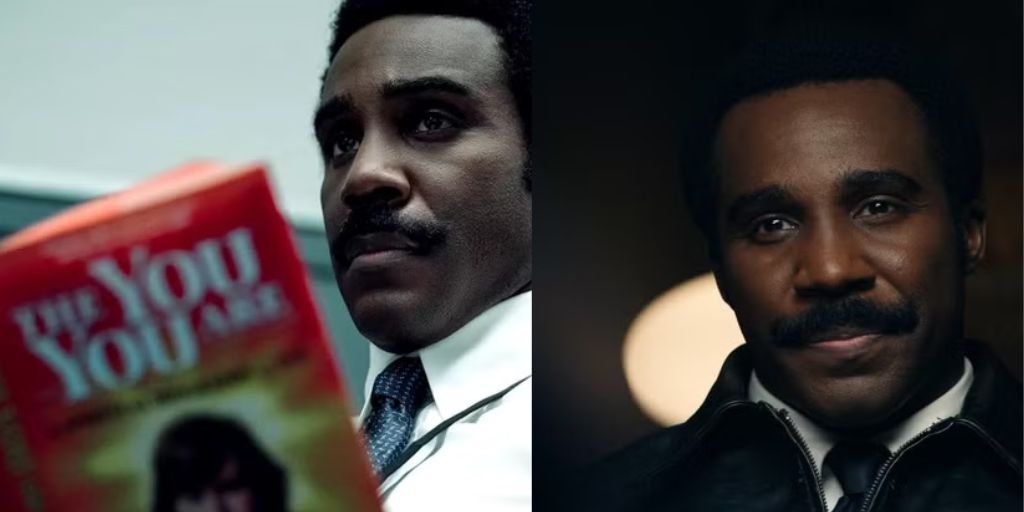Every time Lumon, the secretive company in Severance, does something unethical, it feels like nothing could be worse—until they find a way to prove us wrong.
The company has already crossed many moral boundaries, from forcing innies like Mark (Adam Scott) and Helly (Britt Lower) to endure psychological torment in the Break Room to making Mark unknowingly interact with his outie’s wife, Gemma (Dichen Lachman), whom he believes to be dead.
These are just some of the horrifying ways Lumon exerts control over its employees, and Season 2’s third episode, Who is Alive?, pushes things even further. In this episode, Milchick (Tramell Tillman) receives “re-canonicalized” paintings of Kier Eagan after his promotion. The twist? Lumon has depicted the company’s founder as Black.
At first glance, the scene may appear harmless, but the implications are deeply troubling. The company is not honoring Milchick or embracing diversity. Instead, they are making a deliberate point of separating him from the rest of the organization by reducing his identity to his skin color.
Lumon and its Board claim that they want Milchick to feel included, but their actions expose something far worse. This moment reveals a pattern of microaggressions that reflect the way discrimination often operates today.
The show draws attention to how corporations attempt to mask prejudice behind seemingly positive gestures while maintaining the same power structures that have existed for centuries.
Lumon’s “Gift” to Milchick Is an Insult Disguised as Appreciation
People often say that discrimination has not disappeared; it has simply evolved. Rather than being openly hostile, many now hide their biases behind polite words and gestures. Severance presents this idea clearly through Natalie (Sydney Cole Alexander), who serves as the public face of the Board.
Her job requires her to communicate their decisions without making her own opinions clear. This detachment is evident in the way she delivers the message about the paintings. She does not personally say she supports the decision.
Instead, she carefully states that the Board wants her to tell Milchick she also received this as a gift and was grateful. The phrasing creates distance between her and the statement, making it unclear whether she truly believes what she is saying or if she is simply following orders.
Tramell Tillman, who plays Milchick, even commented on this dynamic in a behind-the-scenes discussion. He mentioned that it is unclear whether Natalie can be considered an “ally” despite being a person of color herself.
The Board’s reasoning for the paintings—that because Natalie accepted the gift, Milchick should too—exposes how easily they dismiss real concerns. They present a false equivalence, assuming that a simple act of approval from one person erases the deeper issues at play.
Milchick’s reaction speaks volumes. He does not openly express anger, nor does he argue. Instead, he remains silent, sharing a tense stare with Natalie. His expression reveals how carefully he must navigate this situation. The moment is filled with unspoken emotions as he processes the weight of what has just happened.
When he finally takes the paintings and places them on a high shelf, hidden away in a closet, it becomes a powerful moment of defiance. He does not reject the gift outright, but he makes a clear decision to remove it from his space. For a character who has always been portrayed as confident and in control, this quiet action speaks louder than words.
Lumon’s Past Makes This Scene Even More Significant
The fact that Lumon was founded in 1865 is impossible to ignore. This was the same year slavery was abolished in the United States, yet it was also the beginning of the Jim Crow era, a time when discriminatory laws kept Black Americans as second-class citizens while pretending that equality had been achieved.
With this historical context in mind, Lumon’s actions in this episode become even more disturbing. Rather than demonstrating genuine progress, the company’s behavior suggests that it has simply changed tactics while maintaining the same oppressive systems.
This theme is reinforced by the artwork seen in the season’s first episode. One painting depicts Kier Eagan, Lumon’s founder, as a Union soldier seemingly granting mercy to four Confederate soldiers.
The imagery implies that Kier is a benevolent figure, positioning himself as a savior while still holding power over others. This mirrors how Lumon presents itself as an organization that uplifts its employees while actually controlling every aspect of their lives.
By giving Milchick the altered paintings, the company is reinforcing a message of dominance. They are not celebrating his achievements. Instead, they are making sure he never forgets his place in their hierarchy. The gift is not a sign of respect—it is a reminder of the difference they see between him and themselves.
This makes Milchick’s quiet rejection of the paintings all the more significant. It is a rare moment where he silently pushes back against the company’s authority, even if only in a small way.
Milchick’s Character Becomes More Sympathetic Through This Moment
Until now, Milchick has been one of Lumon’s most loyal employees. He enforces the company’s rules with an unwavering smile, often taking pleasure in the power he holds over the innies. His ability to shift between warmth and intimidation has made him one of the most unpredictable characters in Severance.
However, this episode adds a new layer to his character. It shows that, despite his commitment to the company, he is not immune to the way he is treated.

This moment does not suggest that Milchick will suddenly turn against Lumon, but it does reveal a crack in his carefully maintained persona. He may still uphold the company’s rules, but now, the audience sees the weight of his role. He is not just someone who enforces the system—he is also someone who suffers under it.
By highlighting this internal conflict, Severance makes Milchick a more complex and relatable character. It forces the audience to consider what it means to be part of a system that does not fully accept you, even when you dedicate yourself to it completely.
This idea extends beyond Lumon, reflecting the reality many people face in corporate environments. The show presents a thought-provoking commentary on how power operates, making it clear that oppression does not always come in obvious forms.
The Scene’s Message Extends Beyond Severance
What makes this episode of Severance so impactful is how closely it mirrors real-life experiences. Many workplaces claim to value diversity and inclusion, but their actions often reveal a different truth.
Token gestures, such as superficial acknowledgments or symbolic gifts, do not address deeper structural issues. Instead, they serve as a way to maintain control while giving the appearance of progress.
By presenting this theme through Lumon, Severance highlights how discrimination has adapted over time. It does not always take the form of outright hostility.
Sometimes, it appears as a forced smile, a carefully worded message, or a seemingly thoughtful gift that carries an entirely different meaning. The show reminds us that true inclusion is not about appearances—it is about meaningful change.
With each new episode, Severance continues to reveal the unsettling truths hidden beneath Lumon’s polished surface. The latest chapter adds another layer to the company’s disturbing history, showing just how far it will go to maintain its power.
As the season unfolds, Milchick’s role may become even more complicated, and this moment could mark the beginning of an internal struggle that will shape his future decisions.




